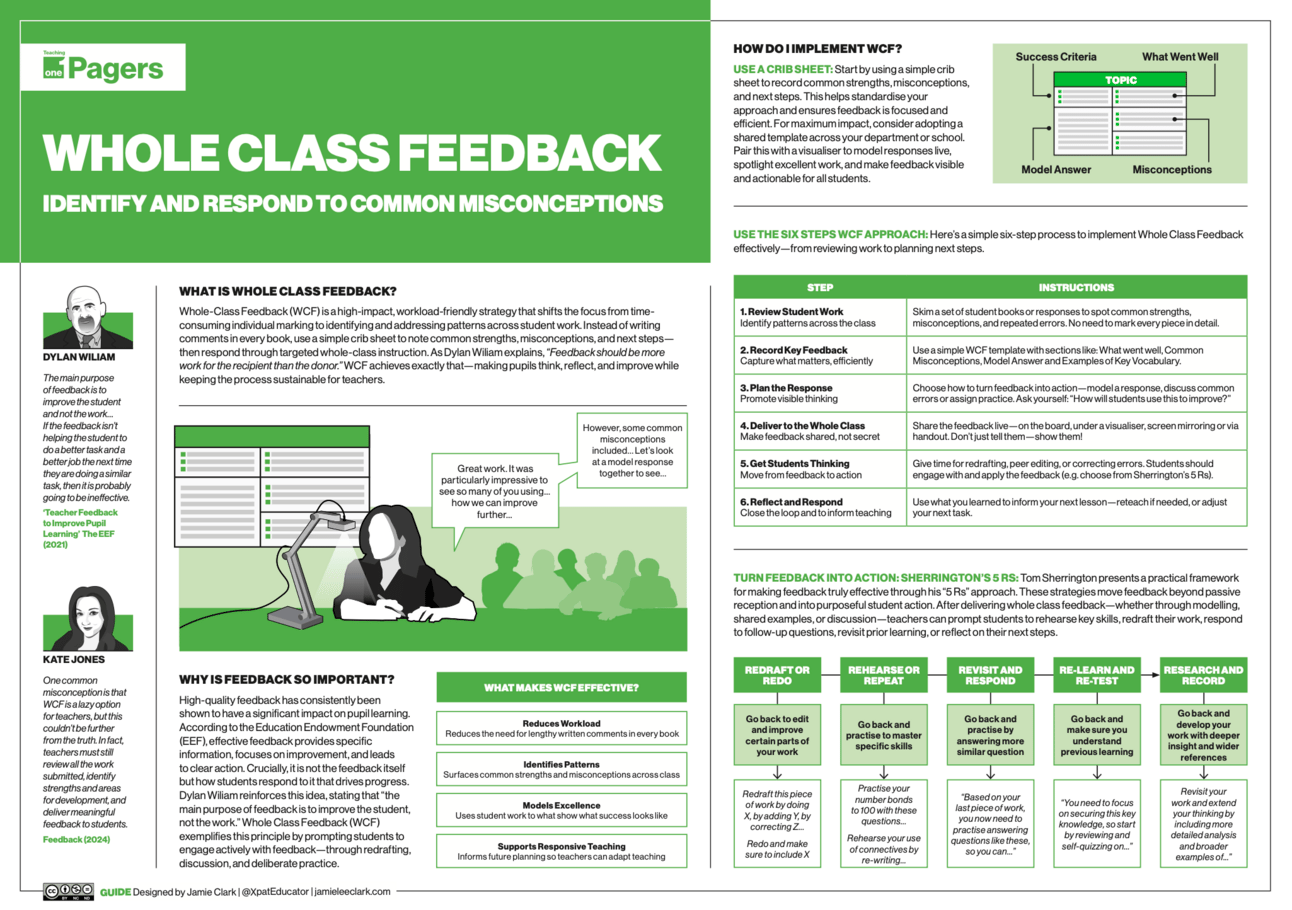👋 Hi {{first name | there!}}
In this edition of ⚗️DistillED, we explore how Whole-Class Feedback (WCF) helps reduce marking workload and sharpen your teaching—without sacrificing impact.

What is Whole Class Feedback?
WCF is a strategy where teachers respond to trends across student work—strengths, misconceptions, errors—by giving feedback to the entire class rather than marking each book individually. After scanning students’ work, it’s typically recorded on a crib sheet and delivered through a live, in-class discussion using examples, modelling, and follow-up tasks.
Educator and author Kate Jones describes WCF as “a more sustainable and effective alternative to traditional marking,” and it’s easy to see why: it saves time and focuses attention where it matters most—on making small steps of improvement to strengthen and secure knowledge in long-term memory.
“One common misconception is that WCF is a lazy option for teachers, but this couldn’t be further from the truth. In fact, teachers must still review all the work submitted, identify strengths and areas for development, and deliver meaningful feedback to students.”
Here’s what makes WCF so effective:
Reduces Workload – Cuts down on written marking by replacing individual comments with targeted whole-class feedback
Highlights Patterns – Surfaces common strengths, misconceptions, and recurring errors across the class
Models Excellence – Uses strong student work and live modelling to clarify what success looks like
Enables Responsive Teaching – Informs planning and reteaching based on real-time learning needs
This strategy transforms a pile of books into a whole-class formative feedback sequence. Here’s what an effective WCF crib sheet looks like—often guided by a simple headings that include:
Success Criteria
What Went Well
Common Misconceptions
Key Vocabulary
Model Answers
Spelling and Grammar Errors

Download the Microsoft Word template by subscribing to ⚗️DistillED+
Why is actionable feedback so important?
Research by Dylan Wiliam emphasises that “feedback should be more work for the recipient than the donor.” WCF embodies this: students reflect on the feedback, edit, and improve based on shared examples and clear action steps. In other words, giving something concrete for them to do to help them do better next time.
“The main purpose of feedback is to improve the student and not the work… If the feedback isn’t helping the student to do a better task and a better job the next time they are doing a similar task, then it is probably going to be ineffective.”
Essentially, Dylan Wiliam emphasises that the true value of feedback lies in how it helps the student grow—not just in fixing errors on a current piece of work. If feedback doesn’t lead to improved performance on future tasks, then it hasn’t served its purpose.
So, how do we make sure our WCF is meaningful and actionable? Let’s look at some strategies.
How do I implement whole class feedback effectively?
Here are five practical strategies (all starting with “R”) from Tom Sherrington’s awesome blog post, Five Ways of Giving Effective Feedback as Actions. These strategies are tailored to ensure WCF drives ongoing improvement. Check it out…

With this in mind, let’s break down the WCF process into 6 key implementation steps:
Step | Explanation | Example |
|---|---|---|
1. Review Student Work → Purpose: Identify patterns across the class | Skim a set of student books or responses to spot common strengths, misconceptions, and repeated errors. No need to mark every piece in detail. | “Most students nailed the opening paragraph, but a lot confused similes with metaphors in the second section.” |
2. Record Key Feedback → Purpose: Capture what matters, efficiently. | Use a simple WCF template with sections like: What went well, Common Misconceptions, Model Answer and Examples of Key Vocabulary. | “What Went Well: Clear paragraph openings with sensory imagery.” “Common Misconceptions: Figurative language errors.” |
3. Plan the Response → Purpose: Promote visible thinking through dialogue. | Choose how to turn feedback into action—model a response, discuss common errors, set a “together task,” or assign follow-up practice. | “I’ll use the visualiser to show a strong intro and then live-edit a weak one. Then students will improve theirs.” |
4. Deliver to the Whole Class → Purpose: Make feedback shared, not secret. | Share the feedback live—on the board, under a visualiser, screen mirroring or via handout. Don’t just tell them—show them! | “Let’s look at this opening. What makes it work? Now compare it to this one—how would you improve it?” |
5. Get Students Thinking → Purpose: Move from feedback to action. | Give time for redrafting, peer editing, or correcting errors. Students should engage with and apply the feedback (e.g. choose from Sherrington’s 5 Rs). | “Use a different colour to revise your second paragraph. Focus on adding figurative detail and sentence variation like in our shared model.” |
6. Reflect and Respond → Purpose: Close the loop and inform future teaching. | Use what you learned to inform your next lesson—reteach if needed, or adjust your next task. | “I’ll revisit similes vs metaphors again tomorrow—it clearly needs more practice before we move on.” |
Until next time — stay curious, stay clear!
Jamie
Where can I find out more?
The One-Page Guide
This free A3 guide summarises whole class feedback and how to implement it effectively to reduce workload and boost student progress.

Looking for unbiased, fact-based news? Join 1440 today.
Join over 4 million Americans who start their day with 1440 – your daily digest for unbiased, fact-centric news. From politics to sports, we cover it all by analyzing over 100 sources. Our concise, 5-minute read lands in your inbox each morning at no cost. Experience news without the noise; let 1440 help you make up your own mind. Sign up now and invite your friends and family to be part of the informed.
Checklist, Slideshow and Crib Sheet
This week’s ⚗️DistillED+ resources include a crib sheet, checklist, and PowerPoint slideshow to use for teacher CPD. They include the WHAT, WHY and HOW of effective whole class feedback implementation.
Upgrade to ⚗️DistillED+ download the content.

Join DistillED+
Members gain access to expertly curated digital evidence-informed content
UPGRADEA ⚗️DistillED+ subscription gets you:
- Full access to new premium one-page guides
- Full access to evidence-informed strategy checklists
- Full access to slide templates (PowerPoint and Keynote)




